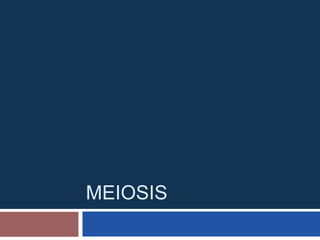Report
Share

More Related Content
What's hot
What's hot (20)
Chapter 18 Cell Division Lesson 4 - The Importance of Mitosis

Chapter 18 Cell Division Lesson 4 - The Importance of Mitosis
Similar to Meiosis
Similar to Meiosis (20)
More from mlong24
More from mlong24 (20)
Recently uploaded
Recently uploaded (20)
Event-Driven Architecture Masterclass: Integrating Distributed Data Stores Ac...

Event-Driven Architecture Masterclass: Integrating Distributed Data Stores Ac...
State of the Smart Building Startup Landscape 2024!

State of the Smart Building Startup Landscape 2024!
Cyber Insurance - RalphGilot - Embry-Riddle Aeronautical University.pptx

Cyber Insurance - RalphGilot - Embry-Riddle Aeronautical University.pptx
Intro to Passkeys and the State of Passwordless.pptx

Intro to Passkeys and the State of Passwordless.pptx
AI+A11Y 11MAY2024 HYDERBAD GAAD 2024 - HelloA11Y (11 May 2024)

AI+A11Y 11MAY2024 HYDERBAD GAAD 2024 - HelloA11Y (11 May 2024)
The Ultimate Prompt Engineering Guide for Generative AI: Get the Most Out of ...

The Ultimate Prompt Engineering Guide for Generative AI: Get the Most Out of ...
TrustArc Webinar - Unified Trust Center for Privacy, Security, Compliance, an...

TrustArc Webinar - Unified Trust Center for Privacy, Security, Compliance, an...
Event-Driven Architecture Masterclass: Engineering a Robust, High-performance...

Event-Driven Architecture Masterclass: Engineering a Robust, High-performance...
Frisco Automating Purchase Orders with MuleSoft IDP- May 10th, 2024.pptx.pdf

Frisco Automating Purchase Orders with MuleSoft IDP- May 10th, 2024.pptx.pdf
Observability Concepts EVERY Developer Should Know (DevOpsDays Seattle)

Observability Concepts EVERY Developer Should Know (DevOpsDays Seattle)
Harnessing Passkeys in the Battle Against AI-Powered Cyber Threats.pptx

Harnessing Passkeys in the Battle Against AI-Powered Cyber Threats.pptx
Event-Driven Architecture Masterclass: Challenges in Stream Processing

Event-Driven Architecture Masterclass: Challenges in Stream Processing
Portal Kombat : extension du réseau de propagande russe

Portal Kombat : extension du réseau de propagande russe
Human Expert Website Manual WCAG 2.0 2.1 2.2 Audit - Digital Accessibility Au...

Human Expert Website Manual WCAG 2.0 2.1 2.2 Audit - Digital Accessibility Au...
Six Myths about Ontologies: The Basics of Formal Ontology

Six Myths about Ontologies: The Basics of Formal Ontology
UiPath manufacturing technology benefits and AI overview

UiPath manufacturing technology benefits and AI overview
Stronger Together: Developing an Organizational Strategy for Accessible Desig...

Stronger Together: Developing an Organizational Strategy for Accessible Desig...
Meiosis
- 1. MEIOSIS
- 2. Mendel: Forgotten? Gregor Mendel published his findings on genetics in 1865 but his work didn’t get much attention In the early 1900’s scientists did experiments similar to what Mendel had done They searched for papers detailing results similar to theirs and realized that their discoveries were not new. Genes were still a mystery though. Scientists didn’t know where they were located or how they passed information from once cell to
- 3. One Makes Two Asexual reproduction: only one parent cell is needed for reproduction Parent cell goes through mitosis and divides into two daughter cells Most single-celled organisms reproduce in this way as do most of the cells in your body
- 4. Two Make One Sexual reproduction: two parent cells join together to form a new individual Parent cells are known as sex cells, different from ordinary body cells Human body cells have 46 chromosomes or 23 pairs of homologous chromosomes
- 5. Human sex cells have only 23 chromosomes Male sex cells are called sperm Female sex cells are called eggs, or ova Each sperm and each egg has only one of the chromosomes from each homologous pair
- 6. Less is More When an egg and sperm join to form a new individual, each parent donates ½ of a homologous pair of chromosomes This ensures the offspring will have a normal number of chromosomes in each body cell
- 7. Meiosis to the Rescue Sex cells are made during meiosis Meiosis produces new cells with half the usual number of chromosomes When sex cells are made, the chromosomes are copied once, and then the nucleus divides twice. Resulting sperm and eggs have ½ the number
- 8. Back at the Lab Walter Sutton read Mendel’s studies which showed that the egg and sperm must contribute the same amount of genetic information to the offspring Using some of his own observations, he came up with the idea that: Genes are located on chromosomes
- 9. What was that again? Mitosis: P M A T/C
- 10. Meiosis: First Time Through Prophase I Metaphase I Anaphase I: Chromosomes separate from their homologous partners and move to opposite sides of cell Telophase/Cytokinesis I: Two cells are formed, each with the same amount of chromosomes as the parent cell
- 12. Meiosis: Going Again Prophase II: Nuclear membranes dissolve again, meiotic spindle fibers form Metaphase II: Spindle fibers attach and line paired chromatids up at equator Anaphase II: Chromatids pull apart and move to opposite poles Telophase/Cytokinesis II: Four new cells have formed from original cell, each with half the number of chromosomes present
- 13. Differences Between Mitosis and Meiosis Mitosis Meiosis One cell divisision Two cell divisions Two daughter cells Four daughter cells Daughter cells have Daughter cells have same number of half the number of chromosomes as parent chromosomes as parent cells cells
- 15. Male or Female? Sex chromosomes carry genes that determine whether the offspring is male or female. In humans, females have two X chromosomes while males have one X chromosome and one Y chromosome. Each egg cell produced by a female contains one X chromosome. A sperm cell produced by a male can contain either an X or Y chromosome.
- 17. Male or Female?
- 18. Male or Female?
- 19. Think/Pair/Share Explain the difference between sex cells and sex chromosomes. If there are 14 chromosomes in pea plant cells, how many chromosomes are present in a sex cell of a pea? How many times do the chromosomes make copies of themselves during meiosis? How many times do cells divide during meiosis?